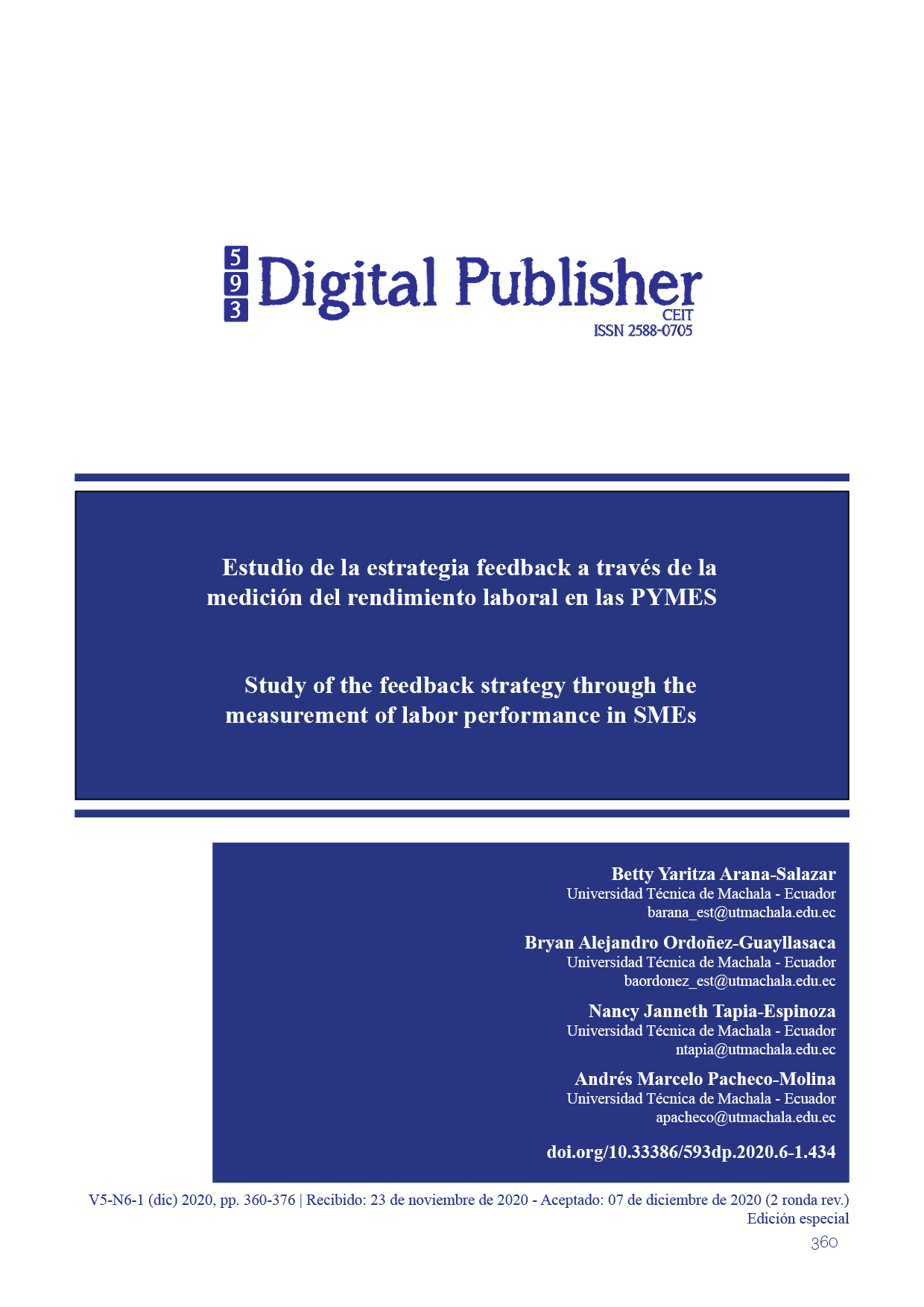Study of the feedback strategy through the measurement of labor performance in SMEs
Main Article Content
Abstract
The companies can be small and medium-sized they have constant changes in the market where their objective is to be competitive and provide a quality product or service to the people called user, but for this they must account with the greatest instrument in an organization such as human resources, who contributes with their abilities and skills in any process or task function, the communication is the method more effective to the relationship the manager with their collaborators, if there are not an effective communication between the manager and the collaborators will not have a good job performance based on what the organization require, for this reason, feedback is an assertive method that seeks with its application to reduce errors and increase benefits for who make up the organization. This research was developed in order to study the feedback strategy determining its impact by measuring performance job in Pymes, it is implementing with a quantitative approach and descriptive research to promote work, the information was collected from 384 employees of Pymes of commerce and service in Machala, through a survey with two blocks, the first block consist of 9 items and the second is about feedback, it is made for 8 items, these data were analyzed and interpreted through the correlation methods in the IBM SPSS statistical program, which we have had the deduction that Feedback maintains a moderate relationship with employee performance, accepting the significant impact of this strategy within organizations.
Downloads
Article Details

This work is licensed under a Creative Commons Attribution-NonCommercial-ShareAlike 4.0 International License.
1. Derechos de autor
Las obras que se publican en 593 Digital Publisher CEIT están sujetas a los siguientes términos:
1.1. 593 Digital Publisher CEIT, conserva los derechos patrimoniales (copyright) de las obras publicadas, favorece y permite la reutilización de las mismas bajo la licencia Licencia Creative Commons 4.0 de Reconocimiento-NoComercial-CompartirIgual 4.0, por lo cual se pueden copiar, usar, difundir, transmitir y exponer públicamente, siempre que:
1.1.a. Se cite la autoría y fuente original de su publicación (revista, editorial, URL).
1.1.b. No se usen para fines comerciales u onerosos.
1.1.c. Se mencione la existencia y especificaciones de esta licencia de uso.
References
Aguilar, S. (2005). Fórmulas para el cálculo de la muestra en investigaciones de salud. Salud en Tabasco, 11(1-2), 333-338. Obtenido de https://www.redalyc.org/pdf/487/48711206.pdf
Amo, A. (2018). Habilidades de comunicación (Vol. 1.0). España: Editorial Elearning, S.L. Obtenido de https://books.google.com.ec/books?id=RG12DwAAQBAJ&pg=PA57&dq=Feedback+positivo:+es+reconocer+a+la+otra+persona+una+determinada+conducta,+lo+que+har%C3%A1+que+su+entusiasmo+y+motivaci%C3%B3n+aumenten.+Se+puede+hacer+en+p%C3%BAblico+o+en+privado,+si+bien+en
Bravo, L., Valenzuela, A., Ramos, P., & Tejada, A. (2019). Perspectiva teórica del diagnóstico organizacional. Revista Venezolana de Gerencia, 24(88), 1-11. doi: ISSN: 1315-9984
Brito, A., Narváez, C., Erazo, J., & Torres, M. (2020). Impacto de los impuestos directos e indirectos en las Pyme de la ciudad de Cuenca período 2016-2018. 593 Digital Publisher, 5(4-1), 119-136. doi:doi.org/10.33386/593dp.2020.4-1.301
Caldas, M., Navarro, A., & Hidalgo, M. (2016). Formación y orientación laboral. s/c: Editex. Obtenido de https://books.google.com.ec/books?id=NglCDAAAQBAJ&pg=PA228&dq=permite+informar+al+receptor+de+la+calidad+de+su+trabajo,+de+manera+que+se+mantengan+los+comportamientos+considerados+como+positivos+y+se+intenten+mejorar+aquellos+que+no+se+est%C3%A1n+realizan
Casares, E. (abril-mayo de 2007). La Comunicación en la Organización; la Retroalimentación como Fuente de Satisfacción. Razón y Palabra, 1-8.
De Alba, C. (2015). Seguimiento del proceso de inserción sociolaboral de personas con discapacidad. España: Ediciones Paraninfo. Obtenido de https://books.google.com.ec/books?id=CdI9CwAAQBAJ&pg=PA20&dq=rendimiento+laboral&hl=es&sa=X&ved=2ahUKEwixi5PrlIfsAhUOr1kKHcO5DkUQ6AEwAXoECAMQAg#v=onepage&q&f=false
Gabini, S., & Salessi, S. (2016). Validación de la Escala de Rendimiento Laboral Individual en Tra- bajadores Argentinos. Evaluar, 16(1), 10-26. Obtenido de https://www.researchgate.net/publication/334078598_Validacion_de_la_escala_de_rendimiento_laboral_individual_en_trabajadores_argentinos
Gabriel, J. (2017). Cómo se genera una investigación científica que luego sea motivo de publicación. Journal of the Selva Andina Research Society, 8(2), 145-146. Obtenido de https://www.redalyc.org/pdf/3613/361353711008.pdf
Garbanzo, G. (2016). Desarrollo organizacional y los procesos de cambio en las instituciones educativas, un reto de la gestión de la educación. Educación, 40(1), 67-87. Obtenido de https://www.redalyc.org/pdf/440/44043204005.pdf
García, J., Galarza, S., & Altamirano, A. (Agosto de 2017). Importancia de la administración eficiente del capital de trabajo en las Pymes. Revista Ciencia UNEMI, 10(23), 30 - 39. doi:ISSN 2528-7737
García, S. (2017). La inteligencia de valores (Vol. 1.0). Alicante, España: Club Universitario. Obtenido de https://books.google.com.ec/books?id=mrBdDwAAQBAJ&pg=PA298&dq=caracteristicas+del+feedback+laboral&hl=es&sa=X&ved=0ahUKEwjwrb6e2-XmAhXNs1kKHQO9CBUQ6AEIODAC#v=onepage&q=caracteristicas%20del%20feedback%20laboral&f=false
Giraudier, M. (2018). Cómo Gestionar el Clima Laboral. Integra.
Hernández, E. (2016). Manual. Valoración, seguimiento, y difusión de acciones de mediación. Madrid: EDITORIAL CEP. Obtenido de https://books.google.com.ec/books?id=-cU-DwAAQBAJ&pg=PA43&dq=mediciones+del+rendimiento+objetivas+y+subjetivas&hl=es&sa=X&ved=2ahUKEwjNxbimop7sAhVCwVkKHQufAAkQ6AEwBHoECAUQAg#v=onepage&q&f=false
Ibarra, M., González, L., & Demuner, M. (2017). Competitividad empresarial de las pequeñas y medianas empresas manufactureras de Baja California. Estudios fronterizos, 18(35), 107-130. doi:https://doi.org/10.21670/ref.2017.35.a06
Jiménez, F. (enero-abril de 2015). Uso del Feedback como Estrategia de evaluación: Aportes desde un Enfoque. Revista Electrónica “Actualidades Investigativas en Educación”, 15(1), 1-24. Obtenido de https://www.redalyc.org/pdf/447/44733027035.pdf
Koopmans, L., Bernaards, C., Hildebrandt, V., Buuren, S., Beek, A., & Vet, H. (2012). Development of an Individual Work Performance Questionnaire. International Journal of Productivity and Performance Management, 6-28. Obtenido de https://www.researchgate.net/publication/233944832_Development_of_an_Individual_Work_Performance_Questionnaire
Mondragón, M. (2014). USO DE LA CORRELACIÓN DE SPEARMAN EN UN ESTUDIO. Articulos de Reflexion, 8(1), 98-104. Obtenido de https://dialnet.unirioja.es/servlet/articulo?codigo=5156978
Mora, E., Vera, M., & Melgarejo, Z. (2015). Planificación estratégica y niveles de competitividad de las Mipymes del sector comercio en Bogotá. Estudios Gerenciales, 31(134), 79-87. Obtenido de https://www.redalyc.org/pdf/212/21233043009.pdf
Muñoz, M., Cabrita, M., & Ribeiro, M. (2015). Técnicas de gestión empresarial en la globalización. Revista de Ciencias Sociales, 346-357. Obtenido de https://www.redalyc.org/pdf/280/28042299006.pdf
Rivero, Y. (2019). Evaluación del desempeño: tendencias actuales. Revista Archivo Médico de Camagüey, 23(2), 159-164. Obtenido de http://scielo.sld.cu/scielo.php?script=sci_arttext&pid=S1025-02552019000200159
Sánchez, M., Sánchez, P., Cruz, M., & Sánchez, F. (2014). Caracteristicas Organizacionales de la Satisfacciòn Laboral en España. Revista de Administração de Empresas, 537-547. Obtenido de https://www.redalyc.org/articulo.oa?id=155131802006
Steelman, L. A., Levy, P. E., & Snell, A. F. (2004). The Feedback Environment Scale: Construct Definition, Measurement, and Validation. Educational and Psychological Measurement, 64(1), 165-184. Obtenido de https://www.researchgate.net/publication/247728554_The_Feedback_Environment_Scale_Construct_Definition_Measurement_and_Validation
Urcola, J. (2015). Manual práctico de comunicación empresarial. Madrid: ESIC. Obtenido de https://books.google.com.ec/books?id=LayMCgAAQBAJ&pg=PT155&dq=feedback+empresarial&hl=es&sa=X&ved=0ahUKEwiEhIuBtMrmAhVCVs0KHdhmA1wQ6AEIJzAA#v=onepage&q=feedback%20empresarial&f=false
Urdaneta, A., González, A., Luciani, L., & Borgucci, E. (2019). Valor Agregado y Nivel Competitividad de las pymes en el Cantón Machala, Ecuador. Visionario Digital, 3(2), 245-265. doi:https://doi.org/10.33262/visionariodigital.v3i2.422
Zapata Guerrero, E. E. (2004). Las PyMES y su problemática empresarial. Análisis de casos. Revista Escuela de Administración de Negocios, 119-135. Obtenido de https://www.redalyc.org/pdf/206/20605209.pdf
Zuluaga, M. (2017). El estudiante y la retroalimentación. Papel en la educación médica. Acta Médica Colombiana, 42(3), 193-194.





